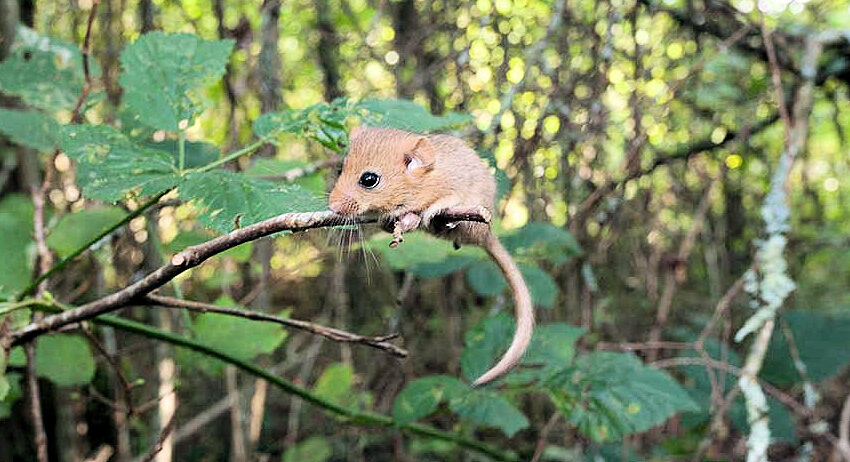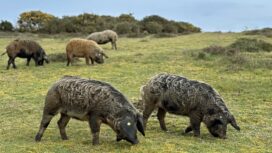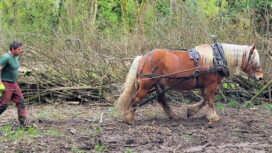One of Britain’s most iconic mammals, the hazel dormouse, has all but disappeared from Purbeck in Dorset as numbers of the nocturnal creature plummet across England.
Populations of the hazel dormouse, immortalised in Lewis Carroll’s Alice in Wonderland at the Mad Hatter’s tea party, have plunged by 70 percent in the last 20 years alone.

Dormice will spend up to five months of the year in hibernation
Now extinct in 20 counties
The tree dwelling rodents are now extinct in 20 northern and midland counties in England and the species must be reclassified as endangered on the international nature conservation’s red list, according to a study by the People’s Trust for Endangered Species (PTES).
The Mammal Society estimate there to be about 900,000 dormice in England and Wales, down from around 2.5 million in 2000.
Although dormice are still clinging on in southern counties like Dorset, Purbeck’s mild winters are partly responsible for falling numbers.
Dormice hibernate in nests from November until spring, but milder winters mean they are now frequently waking up and starting to forage for food when there is none available – between 40 and 70 percent of dormice die during the hibernation period.
In Purbeck, there are thought to be no dormice in the Durlston Country Park, on any National Trust land or at the RSPB Arne national nature reserve.
At Arne, deer have massively overgrazed the scrubby understorey to coppices, destroying the habitat for dormice and also affecting populations of nightingales for the same reason.
A small number of dormice are thought to live on Dorset Wildlife Trust land at Kilwood, near Blue Pool, in the Corfe Castle area and in Wareham Forest, but they are facing a double whammy of habitat and climate change.

Wareham Forest is one of the few areas in Purbeck with a dormouse population
“A growing danger to dormice”
Ian White, dormouse officer at PTES, said:
“Although dormice live in trees, they feed in the scrubby understorey in woodlands, which is being lost – partly because of increased browsing by deer, and also because there is increased shade as we don’t cut our woodlands enough.
“Now winters are becoming more mild and variable, there’s a growing danger to dormice as they wake up too early, and they can only do that so many times before they run out of energy.
“Wetter springs and summers also stop dormice feeding because their fur is not waterproof so they don’t go out in rain, and they only produce on average four young per year – they don’t have the breeding potential of mice and rats.
“If the decline continues at the present rate, in another 30 years the dormouse population will have fallen by 94 percent since 2000, which we simply cannot let happen.”

A dormouse survey in progress by members of the PTES

The National Trust is helping dormice in Somerset and Wiltshire, but has none to look after on Purbeck estates
“Hedges are still cut too often”
Dorset Mammal Group’s dormouse specialist Angela Price agreed:
“The reason that dormice are declining is due to the decline in their habitat and the changing climate. When the winters are mild they tend to wake up and wander around looking for food, but there is little around for them.
“Managing the woodland they like will help, but for dormice to thrive they need green corridors to move around in so that there is mixing of the gene pool, and having a network of hedgerows across Purbeck is the best thing for that.
“Unfortunately, hedges are still cut too often, which might keep them looking neat, but isn’t wonderful for the wildlife.
“Once you have movement between dormice colonies – and as a species they are not very mobile – then they can and will prosper. The problem is that we are decimating all the areas which are wildlife friendly, whether it is hedgerows being lost, or ponds drained.”

Hazel may be a dormouse’s favourite food, but they can survive away from coppices
A flagship species for woodland health
With its golden fur, big black eyes and furry tail, the hazel dormouse is a flagship species for the conservation of many woodlands, its presence an indicator of wider animal and plant diversity, and woodland health.
PTES volunteers have been regularly checking hundreds of dormouse nest boxes in woodlands across the country since 1990, and the Dorset Mammal group also carries out surveys in several locations between April and the end of October.
Angela Price added:
“If you want people to save the dormouse, they should be familiar with it. I once took a retired environment editor on a dormouse survey with me, who had been on safari and had travelled all over the world, but had never seen a dormouse.
“When we found one he was so excited, like a schoolboy, he couldn’t believe how beautiful it was, with its big eyes, nestling in the palm of his hand. If only we could do that with more people we might have a chance of saving them.
“A person who has seen a dormouse will be much more vocal about their protection than someone who hasn’t. They don’t do any commercial damage to anything and once people have seen them they fall in love, but we do need to get more people involved in protecting them.”

The dormouse’s name comes from the French word dormir, to sleep, and that’s what they’re best at
Sufficient habitat to support dormice
Durlston Country Park in Swanage has a suitable habitat for dormice but sadly none have been found. Ranger Ali Tuckey said:
“When I went to college, it was thought that dormice only lived in hazel coppices, so that’s the only place where people looked, which gave quite low estimated numbers.
“But then people started asking what would happen if we looked in other places, like forestry plantations and coastal scrub, and started finding dormice.
“So about 12 years ago we started looking in the coastal scrub at Durlston Country Park, but we didn’t find any – although we did find some nice unexpected mammal species like yellow necked mice.
“We think we are just too isolated from any other populations of dormice because they don’t travel very far, and if they are not in an area it’s very hard for them to get there unless they are put there.
“At Durlston, it’s quite plausible that we have sufficient habitat here to support a dormouse population, but the only way we could do that would be with a reintroduction.
“We are looking at opportunities for reintroducing species to Purbeck – not dormice at the moment, but who knows what might happen down the line if we can be confident we can join up all our landscapes better.”

The Dorset Wildlife Trust reserve at Kilwood, near Blue Pool, Wareham is thought to be home to dormice

With help from the public and landowners, dormice can still be saved
Further information
- Help bring the wild back to life with the People’s Trust for Endangered Species PTES
- The Dorset Mammal Group runs annual dormice surveys – join up via its website





